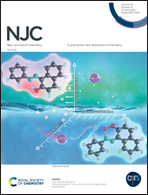Self-assembled organic molecules with a fused aromatic ring as hole-transport layers for inverted perovskite solar cells: the effect of linkers on performance†
Abstract
In this paper, two D–π–A structured self-assembly monolayers (SAMs: FNE29 and DT-1) are self-assembled onto the indium tin oxide (ITO) substrates as hole-transport layers (HTLs) for inverted perovskite solar cells (PSCs). Due to the presence of a terminal –COOH group, the SAMs can be adsorbed onto the surface of the ITO substrate through the covalent self-assembly. The employed FNE29 and DT-1 SAMs differ in the π bridge (linker); the FNE29 SAM has a hexyl-substituent terthiophene while the DT-1 SAM contains dithienopyrrolobenzotriazole as the linkers, respectively. Upon the self-assembly of ITO with the SAMs, the power conversion efficiency (PCE) is enhanced from 9.36% for the control device to 16.75% for the FNE29 modified device and further to 20.65% for the DT-1 modified PSCs. As the D–π–A structured SAMs with a large fused π bridge as a linker is beneficial for hole transfer, the self-assembly of DT-1 achieves a higher PCE with an improved fill factor. Moreover, due to the good hydrophobic characteristics of the SAMs, the inverted PSC devices self-assembled with these two molecules display good stability, maintaining over 80% of the original PCE after storage in air (relative humidity of 20–30%) for ∼1000 h without encapsulation. In addition, the FNE29 and DT-1 based devices also show good photostability after operating for 1000 h. These results indicate that the D–π–A structured SAMs with large conjugated fused π bridges as linkers have obvious advantages as the HTLs for inverted PSCs.



 Please wait while we load your content...
Please wait while we load your content...